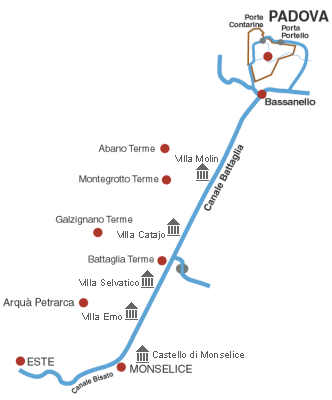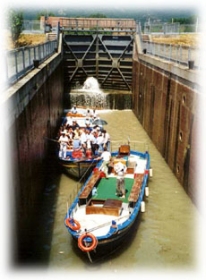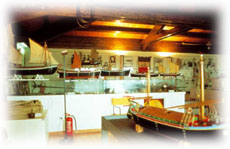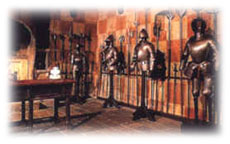 Francesco Petrarca, fascinated by the beauty of this place, liked to compose
his rhymess while navigating up the Riviera
Euganea canals to reach his vineyard in Arquà.
Francesco Petrarca, fascinated by the beauty of this place, liked to compose
his rhymess while navigating up the Riviera
Euganea canals to reach his vineyard in Arquà.Landowners, artists, tradesmen, wayfarers and prelates travelled on the Battaglia Canal to reach the Villas and the Castles scattered along the Euganean Riviera or to join in the numerous commercial activities which took place at Battaglia. The Euganena Riviera was the route preferred by the Venetian nobles and patricians to get to their Villas, built along the canal, and to their residences on the "mountains", the Euganean hills, like Villa Barbarigo, its old boat moorings are still visible today. The Battaglia canal, completed in 1201, commences in Padua, in the ancient harbour called Bassanello, and runs straight to Battaglia Terme, carrying further on to Moncelice and finally meeting the Bisato canal. Its course from Padua is embedded in green and high banks,  on
the right side it is still possible do admire the original hauling line
rode by horses to pull barges. Beyond the first bridge, it is possible
to admire Scamozzi's Villa Molin,
embellished with a high pronaos and beautifully frescoed inside. on
the right side it is still possible do admire the original hauling line
rode by horses to pull barges. Beyond the first bridge, it is possible
to admire Scamozzi's Villa Molin,
embellished with a high pronaos and beautifully frescoed inside.Villa Molin is the first of an interesting succession of important Villas and noble residences build along the Battaglia Canal, similar for their style and architecture to the villas along the Brenta Riviera. A stop in order to taste the wines produced in a nearby farm and then the journey proceeds in a mutable environment of luxurious green vegetation and thick reed thickets, nd reaches an ancient bridge which, in the shadow of age-old platens, stands out opposite to Catajo Castle,  a
late-renaissance (1572) sumptuous residence, magnificently frescoed by
Gianbattista Zelotti (1526-1578). a
late-renaissance (1572) sumptuous residence, magnificently frescoed by
Gianbattista Zelotti (1526-1578).Here is Battaglia Terme, old coastal village built on the convergence of numerous watercourses linked among them by Locks, and characterized by a double line of houses facing the canal and by an interesting stone-steps bridge whose architectural style was clearly influenced by the Venetians.  Then
the journey continues thorugh the lock,
a monumental hydraulic artefact which enables the descending of a 7-metre
high water slope and the docking at the Fluvial
Navigation Museum guarding the historical testimonies of a lost fluvial
civilisation. Then
the journey continues thorugh the lock,
a monumental hydraulic artefact which enables the descending of a 7-metre
high water slope and the docking at the Fluvial
Navigation Museum guarding the historical testimonies of a lost fluvial
civilisation. The journey continues and on the right, on the top of St. Elena hill, the sixteenth-century Villa Selvatico-Sartori stands out with a stricking dome, an imposing seventeenth-century sculptured staircase and a magnificient garden redesigned by Jappelli in 1818. Inside, the buoilding guards frescoes by Luca Ferrari and Lorenzo Bedogoni from Reggio (1650) telling the legend of Antenore. The Villa was reached in the past by old burchielli as the sixteenth-century Villa Barbarigo surrounded by a magnificient Italian-style garden measuring over 50,000 sqare metres, which still has the old mooring. And then Rivella and  Villa Maldura Emo Capodilista,
a Palladian Style Villa attributed to Scamozzi "pupil" of Palladio.
The building is surrounded by an Italian-style garden whose carefully
kept parterres are spaced out by blooming rose beds, fish bonds, hornbeam
galleries and perennial flowers hems.
Villa Maldura Emo Capodilista,
a Palladian Style Villa attributed to Scamozzi "pupil" of Palladio.
The building is surrounded by an Italian-style garden whose carefully
kept parterres are spaced out by blooming rose beds, fish bonds, hornbeam
galleries and perennial flowers hems.The river journey continues in a suggestive scenario of plains extending to the foot of the Euganean Hills, and ends in the harbour of Monselice, town surrounded by walls and a once defensive rampart, historical testimonies of which, like Cà Marcello Castle and the medieval stronghold Rocca, are still visible. |